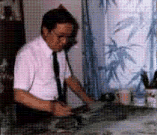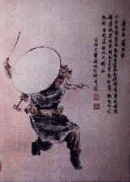

|
A glimpse at an Imperial Legacy |

Artist Aixinjuelo Yuhuan bridges centuries-old China with its modern- day counterpart through his paintings. |

|
Growing up surrounded by scholarly artists, it is no wonder Aixinjueluo Yuhuan eagerly picked up a paint brush as young child.
"It was a fresh, delightful, new thing to do," say Yuhuan, speaking through interpreter, Dr. Richard John Lynn, U of A's chair of East Asian Studies.
Under the watchful eyes of his father and uncle, Xinru, a famous painter and calligrapher, Yuhuan learned the great traditions of Chinese art, particularly those practised in the Manchu court.

|
That's because Yuhuan hails from a noble family. He was born in 1930 in Beijing in the Prince Gong palace. His family is from the Imperial Manchu Aixinjueluo clan, and he is the nephew of the last emperor of China. This was the foundation upon which he built his career, one which includes a diversity of artistic activities: cartoonist, arts editor, illustrator, author, film consultant and arts and crafts designer.

|
Yuhuan is also an accomplished musician, a scholar of Chinese folk music, and a three-stringed lute player.
He chose to major in visual arts for his fine arts degree at Beijing Normal University but studied Western style painting. Chinese art was not an option. Studying the works of Soviet painters was.

|
By the time Yuhuan graduated in 1953, he says he realized all great works of art are similar in principle. "Like people, there are different lifestyles, different countries. As we sit here together, from different cultures, we basically think the same things," says Yuhuan.

|
Known for his meticulous attention to detail, Yuhuan says landscape painting is his favorite. The figurative paintings hanging in the Fine Arts Building as part of his exhibition were done long ago, he says, when his eyesight was much better. "I can't make things up," says the artist. "I must paint things as they look."
Depicting reality-this is what a true "palace" artist must do, as the traditions of his ancestors hold him to do. That is why the serene woman by the waterfall leans ever so slightly to listen to the rush of the water behind her. And the mist rises delicately into the air, as if to moisten the gallery it's hanging in.
The Manchu traditions go back to the 17th century, when an Italian Jesuit priest, Giuseppe Castiglione, arrived in the Qing court, which ran from 1644-1911. Castiglione became a typical court painter and had a lasting impact on Manchu artists. The painting of abstracts and ideas is directly opposite to the Manchu court tradition. Yuhuan's family emulated the realistic style of the Ming and Qing dynasty masters.
Like all Manchu court artists, Yuhuan's paintings are attempts at capturing the spirit of his subjects. As a result, there is much symbolism in each precisely placed tree, rock, bird or flower.
When asked what people can learn from his paintings, the artist modestly refrains from answering. Instead, he explains the purpose of the exhibition. Yuhuan wants to bring Chinese culture closer to the Western world, to expose the works to everyday people.
And he's helping his paintings come to life at the University of Alberta in more ways than one. Proceeds of the sale of his works will go to two causes: to help the poorer areas of China; and to initiate a fund-raising campaign for a Chinese garden at the U of A's Devonian Botanic Garden.
Dr. Dale Vitt, director of the garden, says about six acres of land were set aside for the project after a discussion with Edmonton's Chinese community last year. And in a few short years, Albertans will enjoy the artistic tranquility of a Chinese garden.
Imperial Legacy: Paintings of Yuhuan is on at the Fine Arts Building Gallery until November 9, 1997.
![[Folio]](http://www.ualberta.ca/~publicas/folio/gif/small/folio.gif)
Folio front page |
![[Office of Public Affairs]](http://www.ualberta.ca/~publicas/gif/small/opahome.gif)
Office of Public Affairs |
![[University of Alberta]](http://www.ualberta.ca/~publicas/gif/small/uahome.gif)
University of Alberta |